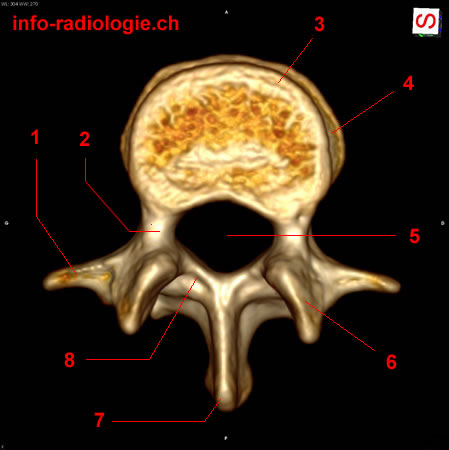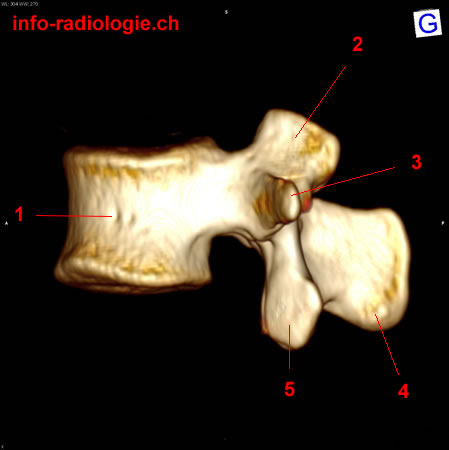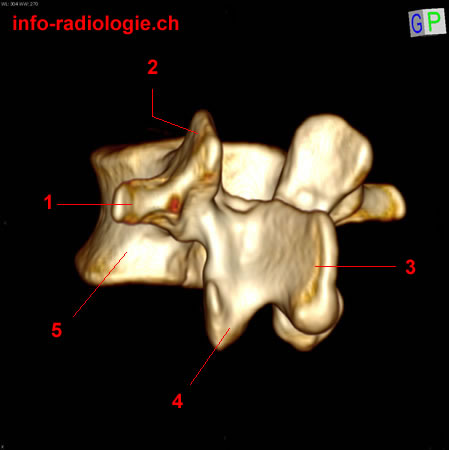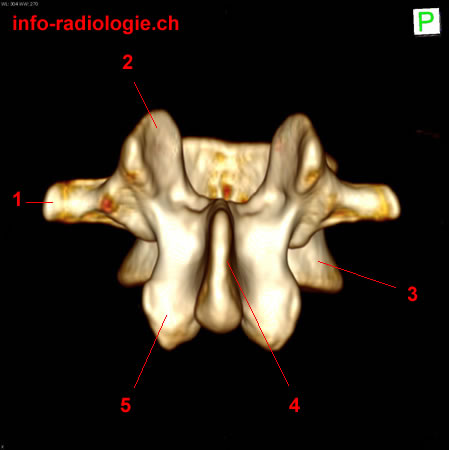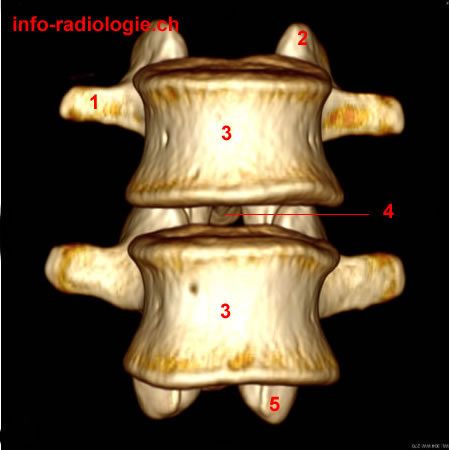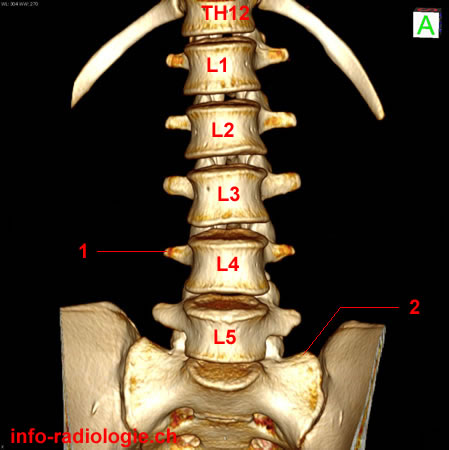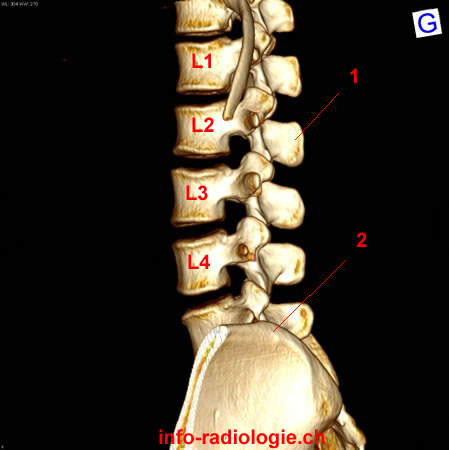This photo gallery presents the anatomy of lumbar spine by means of 3D-reconstructions obtained from a CT-scan.
The Lumbar Spine
The spine consists of three main segments: the cervical spine, thoracic spine, and lumbar spine(1).
The cervical spine refers to the upper part of the spine(2). It consists of seven vertebrae or bones.
The thoracic spine is the center portion of the spine containing 12 vertebrae(3).
Meanwhile, the lumbar spine refers to the lower portion of the spine. It usually consists of five vertebrae(4). However, other people may have six lumbar vertebrae. Having six vertebrae does not cause harmful effects.
The lumbar spine has a lordotic curve. This shape is like a backward C.
Moreover, the vertebrae in the lumbar spine are the largest in the whole spine(5). Thus, the lumbar canal is larger than the cervical or thoracic parts of the spine.
Given its size, the lumbar spine allows more space for the nerves to move about(6). The lumbar spine also helps support the upper body(7).
Compared with other regions of the vertebral column, the lumbar vertebrae are significantly larger(8). Thus, they can absorb axial forces delivered from the head, neck, and trunk.
Moreover, the lumbar vertebrae form a canal that helps protect the spinal cord and spinal nerves(9). This arrangement facilitates the communication of information from the central nervous system to the lower extremities and vice versa.
The lumbar spine also provides various types of truncal motion, such as flexion, extension, side bending, and rotation(10).
Several muscles use the lumbar vertebrae as attachment points(11). These muscles facilitate smooth movement. They also play a secondary role in protection and stabilization.
Muscle strains in the lumbar area result from abnormal tension on a tendon(12). Overstretching a muscle, repetitive use, and muscle tearing due to excessive force can lead to muscle strains.
3D Reconstruction of Lumbar Vertebrae From a CT Scan
Accurate three-dimensional (3D) reconstruction of bone structures is crucial in assessing bone deformation and surgical planning(13).
Computed tomography (CT) is a common medical imaging procedure that employs X-ray images acquired from different angles around the body(14). It uses computer processing to provide cross-sectional images of the bones and blood vessels.
CT scan images produce more-detailed information than plain X-rays(15).
A CT scan with 3D reconstruction shows bony detail more clearly than any other imaging test(16). Moreover, it also displays soft tissues and nerves.
However, a CT scan induces a high radiation dose to patients(17). Several diseases, like scoliosis, require frequent scans for clinical follow-up exams. Thus, this method involves an increased risk of radiation exposure.
Moreover, a CT scan is expensive(18). It requires the patient to stay in a lying position, changing the global shape of bone structures.
It is best to consult healthcare professionals when one feels chronic lower back pain and other lower back conditions to determine the right procedure and plan for surgery if needed.
How to Prevent Low Back Pain
Lower back pain is a common condition(19). Because it is connected to the pelvis, the lumbar spine is where most of the weight-bearing and body movements occur. Hence, it is where people place excessive pressure, such as when lifting a large box or twisting to move a heavy load.
One can consider the following tips to avoid low back pain and prevent possible adverse effects(20).
- Keep a healthy diet. Sufficient daily intake of vitamin D, calcium, and phosphorus helps promote new bone growth.
- Exercise regularly to maintain strong and flexible muscles. Consult with a medical professional to learn low-impact and age-specific exercises that strengthen the lower back and abdominal muscles.
- Use ergonomically designed furniture and other equipment. Ensure that their surfaces are at a comfortable height.
- Switch sitting positions frequently or slowly stretch muscles to relieve tension. Use a back or lumbar support, such as a pillow or a rolled-up towel. Put the feet on a low stool or a pile of books when sitting for a long time.
- Avoid lifting heavy objects. When lifting, keep things close to the body. Lift from the knees and keep the head down and in line with a straight back.
- Sleep on a firm surface. Sleeping on the side with one’s knees drawn up in a fetal position can open up the spine’s joints and strain the neck and back.
- Avoid or quit smoking. Smoking can cause atherosclerosis or the hardening of the arteries, which can trigger lower back pain and degenerative disc disorders(21). Moreover, it causes a high risk for osteoporosis and impedes healing(22). Coughing from heavy smoking can also cause back pain.
- Avoid stressful situations. Such situations can result in muscle tension.
References
- University of Maryland Medical Center. A Patient’s Guide to Anatomy and Function of the Spine. Retrieved from https://www.umms.org/ummc/health-services/orthopedics/services/spine/patient-guides/anatomy-function
- Ibid.
- Ibid.
- Ibid.
- Ibid.
- Ibid.
- Sassack B, Carrier JD. Anatomy, Back, Lumbar Spine. [Updated 2020 Aug 10]. In: StatPearls [Internet]. Treasure Island (FL): StatPearls Publishing; 2020 Jan-. Available from: https://www.ncbi.nlm.nih.gov/books/NBK557616/
- Ibid.
- Ibid.
- Ibid.
- Ibid.
- Ibid.
- Jolivet, E, Campana, S., & Skalli, W. (2011). 3D reconstruction of lumbar vertebrae from computed tomography images. Retrieved from http://www.ors.org/Transactions/57/0623.pdf
- Mayo Clinic. CT scan. Retrieved from https://www.mayoclinic.org/tests-procedures/ct-scan/about/pac-20393675#:~:text=A%20computerized%20tomography%20(CT)%20scan,than%20plain%20X%2Drays%20do
- Ibid.
- American Association of Neurological Surgeons. Spinal Pain. Retrieved from https://www.aans.org/en/Patients/Neurosurgical-Conditions-and-Treatments/Spinal-Pain
- Hosseinian,s., & Arefi, H. (2015). 3D Reconstruction from multi-view medical X-ray images – review and evaluation of existing methods. The International Archives of the Photogrammetry, Remote Sensing and Spatial Information Sciences, Volume XL-1/W5, 23–25. https://www.int-arch-photogramm-remote-sens-spatial-inf-sci.net/XL-1-W5/319/2015/isprsarchives-XL-1-W5-319-2015.pdf
- Ibid.
- University of Maryland Medical Center. Op Cit.
- National Institute of Neurological Disorders and Stroke. Low Back Pain Fact Sheet. Retrieved from https://www.ninds.nih.gov/Disorders/Patient-Caregiver-Education/Fact-Sheets/Low-Back-Pain-Fact-Sheet
- American Association of Neurological Surgeons. Op Cit.
- National Institute of Neurological Disorders and Stroke. Op Cit.

